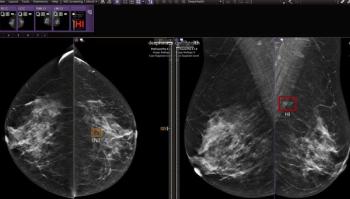
Surgical gel mimics breast microcalcifications
FloSeal Matrix Hemostatic Sealant may stanch bleeding when other techniques fail, but it also spawns microcalcifications on digital or analog screening mammography that could lead to false positives for breast cancer, according to a case series collected by Loyola University radiologists.
FloSeal Matrix Hemostatic Sealant may stanch bleeding when other techniques fail, but it also spawns microcalcifications on digital or analog screening mammography that could lead to false positives for breast cancer, according to a case series collected by Loyola University radiologists.
Dr. Amy Henkel and colleagues describe how the problem arose when FloSeal was used for hemostasis during seven lumpectomies. Their report was published in the American Journal of Roentgenology (2008;191:1371-1373).
The researchers found what appeared to be microcalcifications during follow-up mammograms. Henkel described the abnormalities as innumerable punctate radiopaque densities distributed throughout the lumpectomy site.
The apparent microcalcifications reappeared in the six-month follow-up mammograms of six patients. For the seventh patient, microcalcifications were observed one month after lumpectomy and before radiation therapy in examinations to evaluate for residual malignant calcifications. The finding led to reexcision lumpectomy. Pathology results from the excised tissue revealed numerous benign microcalcifications.
The illusion of cancer from FloSeal appears to be limited to the breast and mammography, according to coauthor Dr. Richard Cooper, a professor in the radiology department at Loyola in Maywood, IL.
Follow-up x-rays acquired after FloSeal was used during urological and cardiovascular surgeries did not present the same problem, he said in an interview.
Baxter International received FDA clearance in 1999 to begin U.S. sales of FloSeal as a tool to achieve hemostasis for all types of surgery, except ophthalmic procedures. The product uses a proprietary gelatin matrix and dehydrated topical thrombin that are combined immediately before use to promote clot formation.
The Loyola group recommended switching to another hemostatic agent for breast surgeries in which pseudomicrocalcifications could be a problem.
"We hope our study will raise awareness for others who may be using this product or any similar product," Henkel said.
Newsletter
Stay at the forefront of radiology with the Diagnostic Imaging newsletter, delivering the latest news, clinical insights, and imaging advancements for today’s radiologists.




























